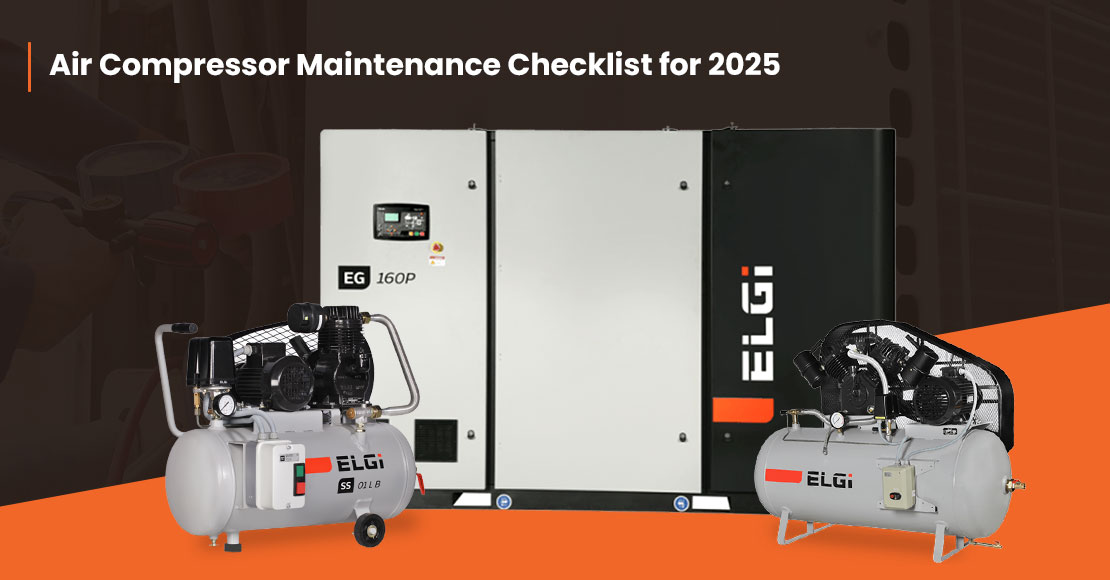Air Compressor Maintenance Checklist for 2025
Air compressors are vital tools across a range of industries, and regular maintenance is essential to ensure they run efficiently, safely, and last for years to come. Whether you use a small, portable unit or a large, industrial-grade machine, sticking to a well-structured maintenance routine will help avoid costly downtime, reduce the risk of accidents, and extend the lifespan of your equipment.
Here’s a comprehensive air compressor maintenance checklist for 2025:
Daily Maintenance
Check Oil Levels (for lubricated units):
Make sure the oil is at the proper level. Check for contamination or signs that the oil needs to be changed. Low or dirty oil can cause damage to the internal components.
Inspect for Leaks:
Pay attention to any unusual hissing sounds or oil puddles around the unit. Leaks can significantly reduce compressor performance and safety.
Drain Moisture:
Condensation builds up in the air tank, which can lead to corrosion and reduced efficiency. Open the drain valve to release the water from the tank and prevent moisture buildup.
Check Air Filter:
Dirty air filters can restrict airflow, reducing efficiency and causing the compressor to overheat. Clean or replace filters as needed.
Weekly Maintenance
Inspect Safety Relief Valve:
Test the safety relief valve by pulling the ring. It ensures the valve is functioning correctly and will prevent over-pressurization, which could cause safety hazards.
Clean Compressor Exterior:
Dust and dirt buildup on the exterior can cause the unit to overheat. Clean the compressor to prevent such problems and to maintain a longer operating life.
Inspect Hoses and Connections:
Look for signs of wear, cracks, or leaks in hoses and connections. Damaged hoses can reduce airflow and pose safety risks.
Monthly Maintenance
Check Belt Tension (if belt-driven):
Ensure the belts are properly tensioned. Loose belts can cause inefficient operation, while frayed belts need to be replaced.
Inspect Fasteners:
Vibration from the compressor can loosen bolts and nuts over time. Tighten any fasteners to prevent further wear and tear on the unit.
Clean Air Intake Vents:
Make sure that air intake vents are free of debris or blockages, which can restrict airflow and cause the compressor to overheat.
Quarterly Maintenance
Test System Pressure:
Verify that the pressure switch and gauges are working correctly and accurately displaying pressure readings. Incorrect pressure can lead to compressor malfunction.
Inspect Motor Bearings:
Lubricate the motor bearings if necessary. Lack of lubrication can cause excessive wear and noise, reducing the motor’s lifespan.
Check Tank for Corrosion:
Inspect the tank both inside (if accessible) and outside for any signs of rust or corrosion. Corrosion can weaken the tank and lead to dangerous situations if left unchecked.
Annual Maintenance
Replace Air/Oil Separator (for Rotary Screw Compressors):
Replace the air/oil separator regularly to ensure oil is effectively separated from the compressed air, maintaining air purity and preventing oil contamination.
Change Compressor Oil:
Follow the manufacturer's instructions for oil changes. Fresh oil ensures smooth operation and reduces wear on moving parts.
Inspect Internal Components:
Have a professional technician conduct a thorough inspection of the compressor’s internal components. This proactive step can prevent more serious issues and keep the compressor running at its best.
Tips for Effective Maintenance
Use Manufacturer-Approved Parts:
Always use parts recommended by the manufacturer. Using the right components ensures optimal performance and extends the life of the compressor.
Keep a Maintenance Log:
Maintain a log of all maintenance performed, including oil changes, inspections, and parts replacements. This log helps track the compressor’s condition and can be useful for future servicing.
Train Your Team on Basic Care:
Educate your staff about basic maintenance tasks, such as checking oil levels and inspecting air filters. Proper knowledge ensures the compressor is kept in good condition at all times.
Schedule Professional Servicing at Least Once a Year:
Regular professional servicing will catch issues that may not be noticeable through basic checks, ensuring your compressor operates efficiently and safely.
Warning Signs of Poor Maintenance
Even with a diligent maintenance routine, certain signs may indicate underlying problems or neglect:
Reduced Pressure or Airflow:
If the compressor isn’t generating sufficient pressure or airflow, it could mean a variety of issues, from clogged filters to faulty components.
Strange Noises from the Unit:
Unusual sounds, such as grinding or squealing, can indicate that parts are wearing out, or there’s a serious issue with the internal components.
Overheating:
If the compressor is running hot, it could mean poor ventilation, dirty air filters, or insufficient lubrication, all of which can lead to more severe problems.
Frequent Breakdowns:
Constant breakdowns or the need for repairs are signs that the compressor isn’t receiving the care it needs. This often leads to costly downtime and a shorter lifespan.
An air compressor is a significant investment in any operation, and keeping it in good working condition is vital for ensuring efficiency, safety, and longevity. By following a structured maintenance routine in 2025, you can prevent potential issues, reduce the likelihood of costly repairs, and maximize the productivity of your air compressor. Stay proactive by regularly maintaining, inspecting, and prioritizing safety. Remember, a well-maintained air compressor not only keeps operations running smoothly but also contributes to the overall safety and success of your business.
